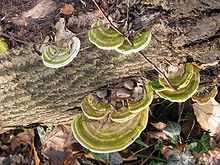Trametes gibbosa
| Trametes gibbosa | |
|---|---|
 | |
| Scientific classification | |
| Kingdom: | Fungi |
| Phylum: | Basidiomycota |
| Class: | Basidiomycetes |
| Subclass: | Agaricomycetidae |
| Order: | Polyporales |
| Family: | Polyporaceae |
| Genus: | Trametes |
| Species: | T. gibbosa |
| Binomial name | |
| Trametes gibbosa (Pers.) Fr., (1836) | |
| Synonyms | |
|
Agarico-suber scalptum | |
| Trametes gibbosa | |
|---|---|
|
| |
| pores on hymenium | |
| cap is offset | |
| hymenium is decurrent | |
| stipe is bare | |
|
spore print is white to cream | |
| ecology is saprotrophic | |
| edibility: inedible | |
Trametes gibbosa, commonly known as the 'lumpy bracket', is a polypore mushroom that causes a white rot. It is found on beech stumps and the dead wood of other hardwood species. Fruit bodies are 8–15 cm in diameter and semicircular in shape. The upper surface is usually gray or white, but may be greenish in older specimens due to algal growth. Elongated pores are located on the under-surface. The fruiting bodies are frequently attacked by boring beetle larvae.
References
External links
- Medicinal Mushrooms description and medicinal effects
| Wikimedia Commons has media related to Trametes gibbosa. |